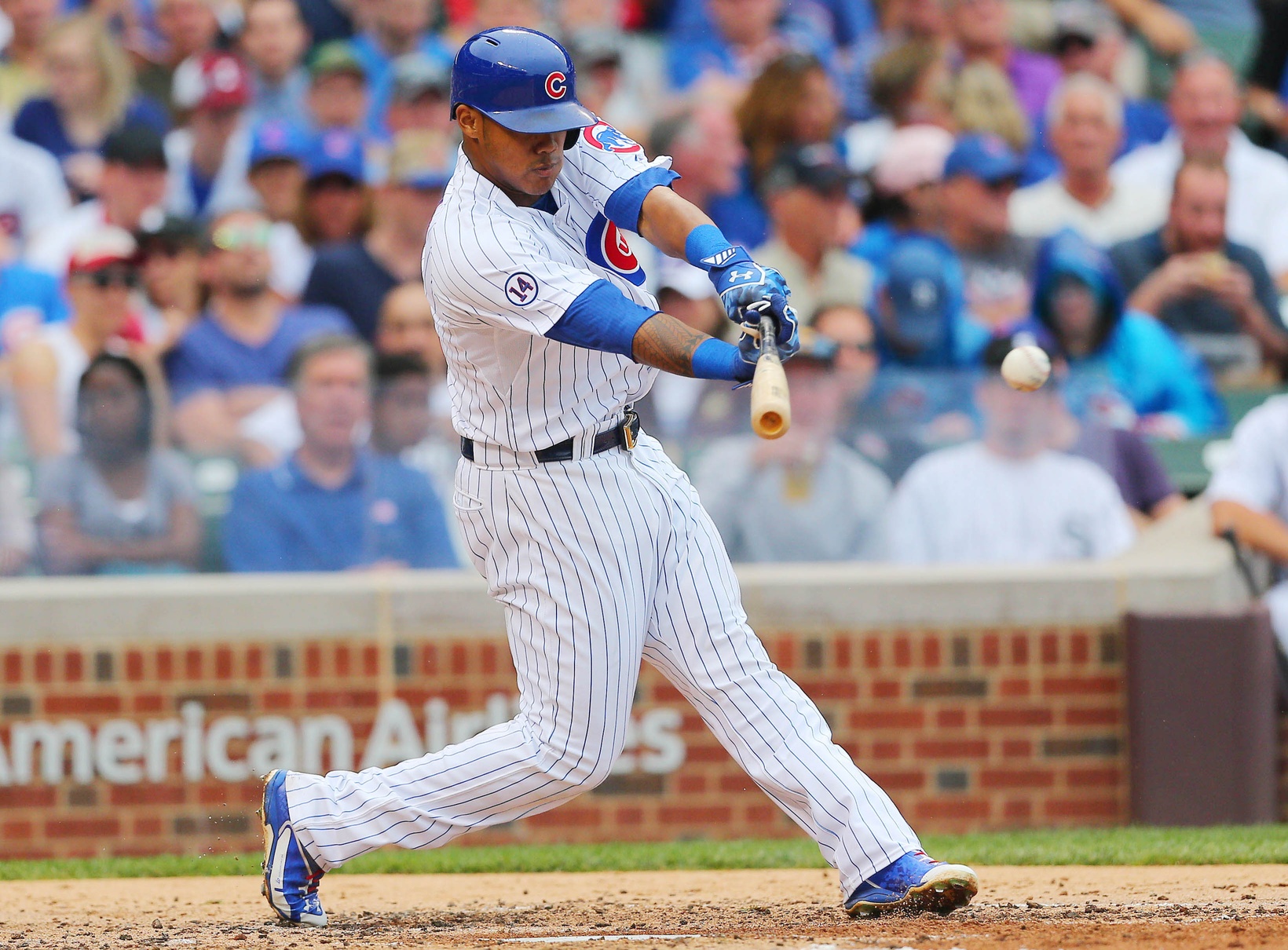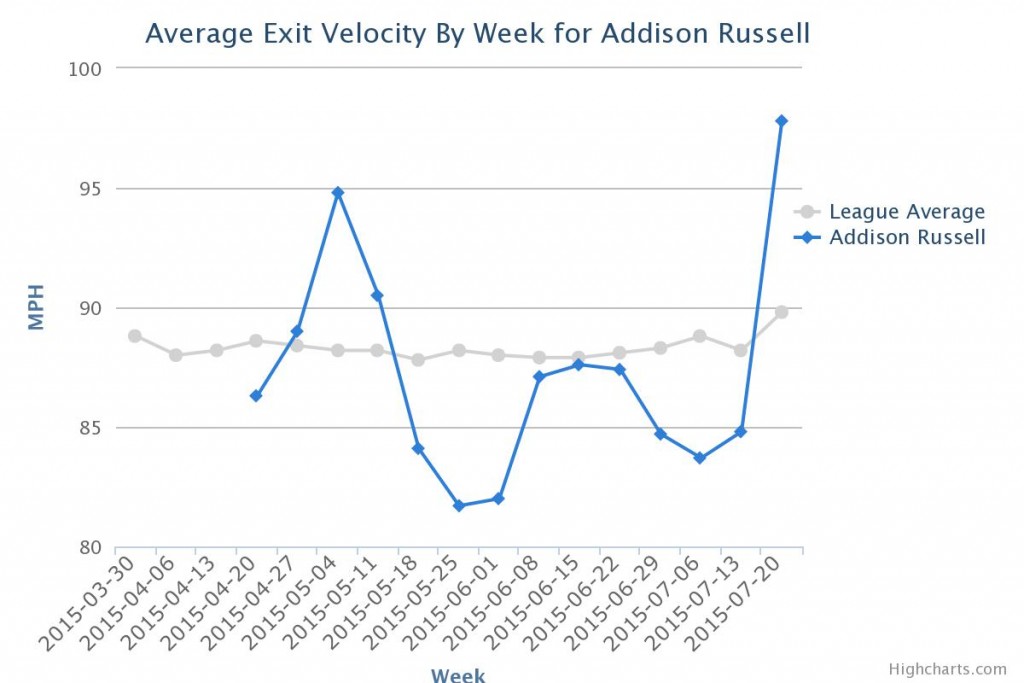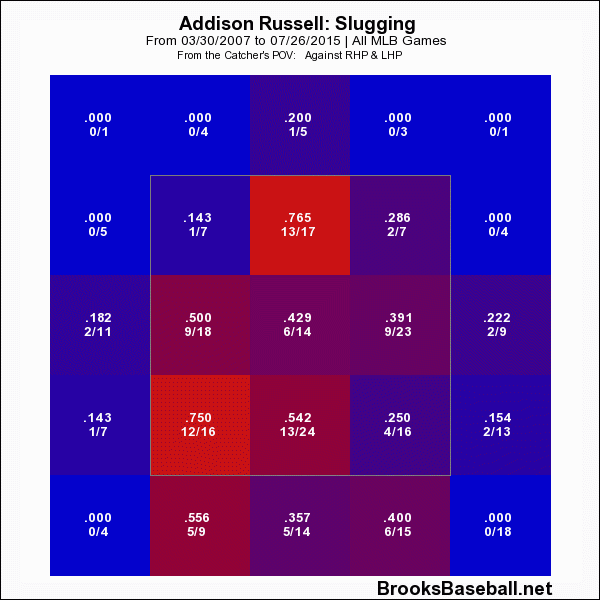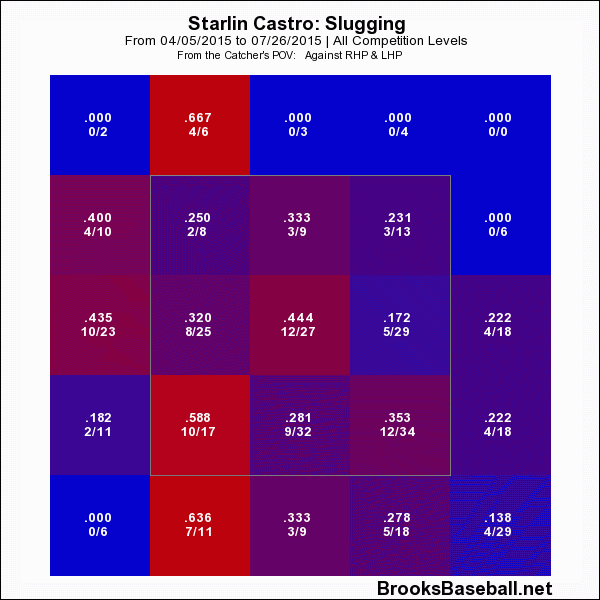Of the Cubs’ hitters, young and old, Addison Russell is the most enigmatic. Kris Bryant has lived up to the on-base portion of his pedigree, if not quite the light-tower power. Jorge Soler’s power has shown up in bursts as well, and he hits the ball harder than almost anyone. Kyle Schwarber—we know what he’s been doing. But, quite simply, we’re not entirely sure what kind of hitter Russell is going to be. So far, he’s been an all-glove, no-hit middle infielder, good for 3.4 FRAA and 1.3 WARP, but a below-average .303 OBP. Will his power show up like we expected when we first saw the broad-shouldered 21-year-old in a Cubs uniform? Or is he destined for an OPS near .700 while flashing that impressive leather?
Fortunately, there are some recent signs of life in Russell’s bat. In July, Russell has upped his walk rate to 15.5 percent and cut his K rate to 24.1 percent, in contrast to his season rates of 9.0 percent and 30.3 percent, respectively. In his nine starts since the All-Star Break, those rates are still strong at 12.1 percent and 21.2 percent, paired with a .276/.364/.414. He’s only totaled two extra-base hits in that time, so the power is still dormant, but overall he’s improved.
Let’s take a look at a few of Russell’s monthly trends in swing rate and whiff rate to see if there’s a basic explanation for this recent uptick in walks and downturn in strikeouts.
Whether it’s fastballs or breaking balls, Russell is both swinging and whiffing less this month than he had in previous months, which is certainly encouraging (his percentages against changeups don’t reveal a trend). Of particular note is the season-long trend in whiffs: against hard and breaking pitches, Russell has swung and missed less often than the previous month in every instance except one. His July whiff rates are season lows of 8.54 percent on hard stuff and 14.08 percent against breaking stuff, the primary culprit for his impressive drop in strikeouts.
This increase in patience versus breaking balls is key, as Russell has struggled to hit sliders so far in his major-league career. Pitchers have exploited that weakness, throwing him more sliders than any other pitch besides four seamers.
Clearly, Russell is reaping the benefits of swinging less and making some more contact when he does, manifested in those improved rates I mentioned at the top. However, I’m curious as to whether this change is having effects in other aspects of his hitting profile. Here’s Russell’s average exit velocity for each week of the 2015 season.
That three week hump in June roughly coincides with his best stretch of the season, from 6/08 to 6/26, wherein he hit .276/.364/.379. Overall, Russell isn’t hitting the ball with authority, excepting the last few games. This makes sense, given his middling slugging, even in his best stretches. Take a look at his zone profile:
One can see his general impotence when faced with pitches up in the zone. He’s not hitting for much for power, and the little bit he is slugging comes off of pitches right down the pipe. Compare Russell’s profile to Starlin Castro’s.
Both have had bad years in terms of slugging, but Castro—he of the abysmal .302 mark this year—has managed to hit for a little power in most of the zone, whereas Russell has a few ice cold spots where he simply does not do damage to pitches yet. I wouldn’t be surprised to see Russell’s profile fill out in terms of slugging, should he continue his recent swing trends. Swinging at fewer pitches in general could indicate a willingness to wait for “his pitch” to hit with authority. The next few weeks will offer more data to confirm or debunk this hypothesis.
Matt Trueblood offered a little hope with regards to the Cubs’ rookies’ second half performances, including Russell, by examining similarly aged and experienced players over the past quarter century. PECOTA, as it is wont to do, projects Russell to stay about the same in terms of his offensive production for the rest of the season. Recently, our good man Rian Watt detailed the top rookies in rest-of-season WARP for the Baseball Prospectus, and Russell came in fourth, just ahead of Soler and behind Bryant, Joc Pederson, and Carlos Correa. Most of that production is a function of his defense, but if the second baseman builds upon these trends in walk and strikeout rate and collects a few more extra-base hits as a result of better patience, we could see his blossoming as a hitter as early as this year.
Lead photo courtesy of Dennis Wierzbicki-USA TODAY Sports




